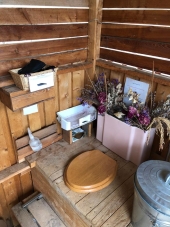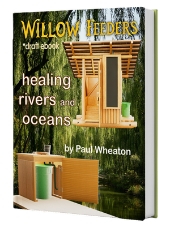
 6
6




 1
1




To understand willow feeders, consider the alternatives.
A septic tank and drain field mixes all the poop, and greywater together, then dumps it into a tank where all the sinkers sink and floaties float. Organic matter breaks down in time. The average septic tank is pumped every four years. If you do a good job caring for what goes into the septic tank, you can go decades.
The watery layer is a sort of poop koolaid that goes to the drainfield which is placed about 18 inches below the ground level. There is a lot of bacterial activity that eats up the poopy bits from the poop koolaid, all year long. It does a pretty good job. But not a perfect job. Some poop koolaid makes it to the ground water supply. Which is why when there is enough population density, it is time to get everybody switched over to a sewage treatment plant.
The missoula sewage treatment plant, like most, collects poop, greywater, and a whole lot of questionable things
[Unwanted paints, herbicides, laundry bleach, powerful soaps and detergents, household toxins, industrial toxins, industrial waste (both legal and ilegal), children's toys going on a magical adventure, "flushable" wipes, feminine hygiene products, dental floss, kitty litter, condoms, cotton balls, cigarette butts, gum, unwanted "legal evidence"]
It also contains a heavy dose of pharmaceuticals that made it through the people that need pharmaceuticals.
Everything is stirred up into a slurry, and screened - this separates the garbage from the sewage. Garbage [like flushable wipes, some TP, feminine hygiene products, plastics, etc.] goes to the landfill. The rest goes to settling ponds. After 24 hours the floaters and sinkers go to a composting facility and the remaining poop koolaid goes past a UV light and is released into the river.
Since I am bonkers about gardening, my attempt at this sort of thing is going to involve gardening.
[Pathogen: For a few ailments, a person's poop can have bits of that sickness in the poop that can make other people sick.] If 4% of all people poop out pathogens, lets assume that a sick person is pooping in every system.
Composting toilets starts with a mixture of poop, toilet paper and sawdust. The pile gets hot in the middle due to the composting process - often exceeding 140 degrees which makes that part of the pile sterile! [Yay! Ding dong the pathogens are dead!] ... In the middle. ... The stuff on the outside sides of the pile didn't get hot enough and still contain pathogens. Advocates for this technique encourage turning the pile frequently in an insulated container so everything (hopefully) gets hot enough at some point.
When done well, the final product is a high quality compost that smells like good soil and is gardener's gold.
Some efforts at this that involve an open pile outdoors. During the composting process, can a fly land on the pile, touch a pathogen, and then fly over to somebody's food and make them sick? And if it rains, are fresh pathogens driven down into the groundwater? Further, most of the piles I have seen are either not turned, or turned only once - this makes me think that most of the contents never reached a hot enough temperature.
But here is another angle about composting in general that has *gardeners* divided.
Start with 100 pounds of compostable materials. Turn it several times. When it is done, you have about 10 pounds of magnificent compost. Where did the rest of it go? The water went into the ground or into the atmosphere. The carbon and nitrogen went into the atmosphere. [our air is 78% nitrogen and xxx% carbon dioxide] But the carbon and the nitrogen are the very things we desperately want in our soils to make our growies happy!
I want to come up with a solution that is safer when it comes to pathogens, and brings more carbon and nitrogen to my growies.
An interesting thing about pathogens ... 99% of them die in about two months. [99% in two months 99.999% in six months 99.9999999999% in two years] And is quite safe in two years. [Faster in a dry environment.]
As it turns out, a dry environment stops the composting action.
So I want to dry it out and set it aside for two years. I also want to keep it from getting onto the ground too early and keep flies out of it.
So we put it in a 32 gallon container with a lid. The lid fits well enough that flies cannot get in, but air can move in and out. As each day warms up, the air inside expands so the moist gasses are pushed out. And as it cools at night, dry air is drawn in.
After two years, we have rich, pathogen free fertilizer. It would be completely safe to put on a veggie garden. But just to make sure that nobody gets weird about human poop and food, let's stick to using it on something non-food. [Willow trees are crazy hungry for this fertilizer!]
This material is not a waste, but a valuable resource. I call all of this "the willow feeder system." Safer than a sewage treatment plant. Cheaper and scalable too.
 1
1



























Working toward a permaculture-strong retirement near sunny Sperling.
 2
2




The best gardening course: https://gardenmastercourse.com
Permies.com FAQ








Gratefully off-the-grid
Alamo Lake, AZ
Zone 9b, 9 inches of rain if lucky!
Perm.Cert. Zaytuna College, Berkley




Jen Anderson wrote:I missed the call! Bummer!
What can be used instead of sawdust? I have very little access to saw dust. I do have access to invasive plants like tamarisk and seasonals like wild mustard. Can I chop that up and put it in? Too green?
Also, I live in a very dry climate where temps reach 120 in the summer...will my Willow feeder explode?

|
please buy this thing and then I get a fat cut of the action:
The new permaculture playing cards kickstarter is now live!
https://www.kickstarter.com/projects/paulwheaton/garden-cards
|









